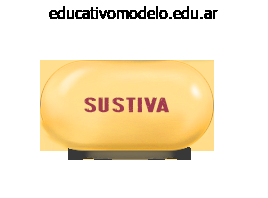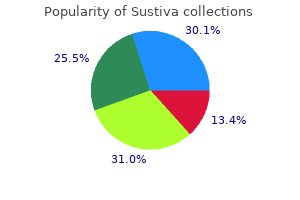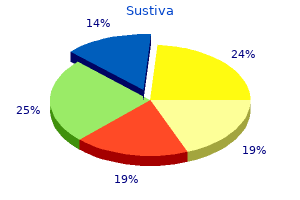Sachin J. Shah, MD, MBA, FAAEM
- Assistant Professor
- New York Medical College
- Attending Physician
- Emergency Medical Associates
- Westchester Medical Center
- Valhalla, New York
Sustiva dosages: 600 mg, 200 mg
Sustiva packs: 10 pills, 20 pills, 30 pills, 60 pills, 90 pills, 120 pills

Sustiva 200 mg buy cheap
Examination of the cranial nerves might help to consider patients suspected of a sinonasal malignancy or a granulomatous process. Topical anesthesia could be accomplished with 4% lidocaine both by way of atomization into the nasal cavities or on pledgets. Use of 2% tetracaine may be helpful in patients who require in-office process, d�bridement, or inadequate anesthesia with topical lidocaine. Oxymetazoline is usually added to the topical anesthetic to present concomitant mucosal decongestion. Positioning Seated and reclined if possible with the affected person head turned dealing with the physician. For patients who require d�bridement, biopsy, or in-office procedures, 2% tetracaine is most popular. The window of toxicity with tetracaine must be thought of, with using doses to not exceed 100 mg. Patients unable to tolerate inflexible endoscopy; uncommon if enough topical decongestion and anesthetic is used 2. Appropriate use of the rigid nasal endoscope to visualize key anatomic landmarks 2. Topical anesthesia and decongestion must be administered before endoscopy (see section on Anesthesia). Patients ought to be positioned appropriately for endoscopy (see part on Positioning). It is useful to flip off the overhead lights for optimal visualization of the monitor through the procedure. The middle meatus is examined bilaterally to reveal the absence of polyps or mucopurulence. In this instance, a 33-year-old male presented with bilateral nasal congestion with seasonal exacerbation in the spring and summer.

600mg sustiva for sale
Social historical past 1) Tobacco use a) Most sufferers within the older age group have a significant historical past of heavy smoking. Bimanual palpation of tumors on the base of the tongue is crucial to most accurately assess the extent of the disease and differentiate the tumor from the lingual tonsils. The incapability of the pharynx to elevate throughout deglutition suggests invasion of the prevertebral fascia in patients with cancer of the posterior pharyngeal wall. Valuable examine to evaluate the primary cancer and to consider for the presence of metastatic most cancers four. This examine could additionally be utilized in cases of most cancers of the posterior pharyngeal wall by which invasion of the prevertebral fascia is suspected. Limited laryngeal elevation in the course of the bariumm esophagram could recommend invasion of the prevertebral fascia Indications 1. Early stage cancer of the base of the tongue (T1/T2) 1) Ideally, these cancers ought to be restricted to the base of the tongue, posterior to the circumvallate papillae. May be used with out neck dissection for benign lesions or low-grade cancers of salivary gland origin d. Benign and malignant tumors arising from the lateral and posterior walls of the oropharynx or hypopharynx, postcricoid space, or base of the tongue (with involvement of the tonsil or lateral wall of the oropharynx) 1) Depending on the extent and placement of tumor, many of those lesions can also be amenable to endoscopic approaches, pending the availability of technology and gear. Direct and indirect visualization of the oral cavity to assess for trismus, examination of the base of the tongue, larynx, and pharynx is important. It can also be important to evaluate the lateral and posterior extent and bulk of the mass as well as involvement of adjoining buildings. Direct laryngoscopy under anesthesia is an important examination to consider tumor extent and infiltration. Cancer of the base of the tongue that extensively includes the tonsil or lateral pharyngeal wall c.

Buy discount sustiva 600mg on-line
Their basic makes use of are as follows: Fisch sort A is usually used for glomus jugulare surgery or different tumors limited to the middle ear cleft. A horizontal incision connects the previous two incisions, extending from the lateral canthus aspect of the WeberFerguson incision posteriorly to the preauricular/scalp incision on the superior attachment of the auricle. In making this incision, frontal branches of the facial nerve shall be recognized, tagged, and transected. Diagrammatic representation of Fisch infratemporal approaches, displaying the approximate degree of cranial base access each provides. B, Exposure of the craniofacial skeleton after reflection of the soft tissue envelope. If not involved within the tumor, it may be reapproximated at the end of the procedure. Osteotomy of the coronoid process could be performed to increase the arc of rotation, taking care to protect the nearby deep temporal arteries. A temporary tarsorrhaphy for 10�14 days may be positioned to stop lower lid ectropion. If the lacrimal system was transected, the lacrimal canaliculi ought to be stented with silicone stents secured in the nasal cavity. E, Frontotemporal craniotomy supplies additional access to intracranial compartments. For in depth tumors, this additional access will enable extirpation of tumor extensions involving the foramen ovale, the foramen spinosum, and the orbital apex, as well as drilling of the clivus if wanted. After the face is prepped with betadine solution (with the eyes lubricated however accessible for monitoring of the pupils and globes), the nasal cavity is ready with pledgets saturated with a topical decongestant. A generously broad maxillary antrostomy is created endoscopically to entry the posterior wall of the maxillary sinus, which is then gently removed to reveal the pterygomaxillary fissure. The sphenopalatine artery is then identified and ligated with either a vascular clip or bipolar cautery.

Buy generic sustiva 200mg line
Use of antibiotics with coverage of anaerobes and beta-lactamase�producing microbes offers good broad-spectrum coverage for many circumstances. Culture�If the patient is steady, obtain an aspirate on the bedside to provoke Gram stain and tradition studies. Antibiotics�Empiric administration of intravenous antibiotics that present cardio and anaerobic coverage four. Dental history-periodontal disease, fractured enamel, periapical abscess, carious tooth d. Perioperative Antibiotic Prophylaxis � Antibiotics that present coverage of aerobes and anaerobes are administered intravenously perioperatively. Instruments and Equipment to Have Available � Head and neck instrument set Key Anatomic Landmarks Management of deep neck area infections mandates a thorough understanding of the anatomy of deep neck areas, etiology of the abscess, and data of the pathogens concerned. The mylohyoid sling divides the submental space into two comparatively impartial sites. Fascial layers envelope muscles, bone, and viscera in the neck and are coalescent in some areas, dehiscent in others. Where multiple layers come together, it is extremely unlikely that infection will unfold past as in the inferior limit of the retropharyngeal house. In regions the place the fascia is thin, deep neck abscesses are in a place to unfold to neighboring spaces if left untreated. The superficial layer lies superficial to the platysma and extends from the upper chest to the zygoma. The superior or "investing" fascia attaches inferiorly to the sternum, clavicle, and first rib, superiorly to the mandible, mastoid, and occipital bone. The lateral portion of the carotid sheath and the stylomandibular ligament are fashioned by this layer. The submandibular and sublingual areas lie deep to this fascial layer, which is bordered by the digastric muscle inferiorly, mandible laterally, hyoglossus muscle medially, and sublingual gland superiorly. The masticator space is bounded medially and laterally by the superficial layer as it splits above the jaw and extends as much as the skull base and zygomatic arch.

200 mg sustiva purchase fast delivery
What imaging modality is helpful to differentiate between the two illness entities What necessary key feature(s) on the imaging examine helps to differentiate between the 2 disease entities What essential landmark needs to be monitored to avoid facial nerve harm when performing a canalplasty Lateralization of the inferior turbinate with a Freer elevator or serial balloon dilations can enhance entry of the posterior nasal cavity in slender passageways. Presence of fever, otalgia, otorrhea, complications, nausea and vomiting, anorexia, sleepless nights, ear tugging, subjective hearing loss, and steadiness disturbance b. Presence of ear popping, fullness, discomfort with barometric problem, or autophony c. Prior remedy: Previous historical past of antibiotic, allergy desensitization, nasal steroid, nasal antihistamine, oral antihistamine, oral steroid, or use of a topical or oral decongestant b. Medical illness: Concurrent rhinitis, rhinosinusitis, adenoid hypertrophy, laryngopharyngeal reflux, craniofacial issues, syndromes, ciliary dysfunction, granulomatous disease, tympanic membrane rupture or perforation, cholesteatoma and tympanic membrane retraction, and atelectasis c. Social historical past: Exposure to tobacco smoke instantly or by way of second-hand publicity f. Tympanostomy tubes are positioned within the pars tensa of the tympanic membrane away from the posterior superior quadrant to keep away from harm to the ossicular chain and chorda tympani nerve. Physical Examination Examination might reveal a normal tympanic membrane, retraction pocket with or with out cholesteatoma, extreme atelectasis, or adhesive otitis media. Endoscopic view of the nasopharyngeal opening of a left eustachian tube showing significant peritubal inflammation. Pneumatic otoscopy and otomicroscopy: that is the gold normal check for otitis media.

200 mg sustiva amex
Thyroid gland: A highly vascular horseshoe-shaped endocrine gland that bridges over the cricoid or upper trachea, overlies the esophagus, and occupies the bilateral central compartment (see Chapter 78). Parathyroid glands: Small (3 to 5 mm) amber-colored endocrine glands deep to the thyroid lobe that management calcium absorption (see Chapter 84). Intraoperative damage to the recurrent laryngeal nerve If initial attention is paid to nerve identification using the laryngeal landmarks listed beforehand previous to management of the visceral injury, the risk is considerably lowered. Preventable by performing meticulous dissection deep to the thyroid and identifying the glands, previous to addressing the perforation. In cases of recognized parathyroid injury, the glands may be minced and reimplanted into neck musculature. Intraoperative parathyroid hormone testing can be used to predict parathyroid function postoperatively, when damage is suspected. Bleeding the common carotid artery, subclavian artery, thyrocervical trunk, jugular vein and superior thyroid vessels, and anterior jugular veins all course by way of this region and, relying on the placement and trajectory of harm, could additionally be concerned. Meticulous dissection and high index of suspicion for preoperative trauma forestall injury to the main vessels. Substernal extension In instances the place the injury or neck an infection extends substernally a Thoracic surgeon should be consulted for intraoperative administration. A transverse cervical incision at the level of the inferior fringe of the cricoid cartilage. However, it may be adapted to a specific need in accordance with the extent of injury and laterality. Axial view of the surgical route to the pharyngoesophagus (retropharyngeal space). The retractor on the left is displacing the sternocleidomastoid muscle and the contents of the carotid sheath.

Generic sustiva 200mg overnight delivery
Inspection of the neck and thyroid gland to consider 1) Symmetry, dimension, firmness, fixation, and associated lymph nodes in addition to proof of earlier neck surgery b. Laryngoscopic evaluation Vocal fold perform must be assessed, especially in repeat surgical procedure or in the case of related thyroid masses. Postoperative bone biopsy has shown suppression of bone resorption and initiation of bone formation. Abnormal glands, recognized on adipose tissue�saturated T2-weighted (hyperintense) imaging, could be distinguished from the surrounding mediastinal adipose tissue utilizing this modality, and gadolinium may help to enhance the irregular glands. Because hyperplasia is the predominant physiologic mechanism, the presence of ectopic glands creates surgical challenges more incessantly (4 occasions higher) as compared with major hyperparathyroidism. Previous neck surgical procedure or explorations represent a relative contraindication; surgery on this setting should be carried out solely by consultants in parathyroid surgery. Dialysis sufferers should bear dialysis 12 to 24 hours or at the latest 36 hours prior to surgery in order to decrease the administration of heparin. Be aware of hypocalcemia, hyperphosphatemia (main explanation for pruritus), hypermagnesemia, and hyperkalemia. Hyperkalemia is an important electrolyte dysfunction to consider in considering common anesthesia and the potential use of muscle relaxants, which may improve serum calcium and end in varied cardiac arrhythmias. All tissue removed at previous surgical procedures should be acquired and reviewed by in-house specialists. Laryngotracheal advanced: the recurrent laryngeal nerve enters the larynx between the cricoid cartilage and the first tracheal ring. Any dissection under the cricoid cartilage requires professional knowledge of the anatomy of the recurrent laryngeal nerve to avoid damage. Recurrent laryngeal nerve: the superior glands often lie posterior to the plane of the nerve whereas the inferior glands lie anterior to the nerve typically. Thyroid gland: Most parathyroid glands lie instantly posterior to or across the capsule of the thyroid gland; identification and mobilization of the gland are required in fourgland explorations. Inferior thyroid artery: Parathyroid glands are often situated close to the junction of the inferior thyroid artery and the recurrent laryngeal nerve.
Cheap sustiva 200mg mastercard
There is a high incidence of cervical lymph node metastasis related to cancer of the taste bud (particularly with squamous cell carcinoma). Treatment of both necks is really helpful for squamous cell cancers involving or approaching the midline. Reconstruction of the soft palate is complicated, and reconstitution of a functional velopharyngeal sphincter is key. Symptoms range widely from asymptomatic to odynophagia, dysphagia, otalgia, airway compromise, oral bleeding, weight loss, modifications in speech, and a mass within the neck. Early lesions are sometimes found incidentally because of dental examinations, ill-fitting dentures, and workplace bodily examinations but also might present at more superior phases. Patients might have hearing loss as a result of middle ear effusion secondary to Eustachian tube dysfunction. Laryngoscopy/pharyngoscopy: assessment posterior/inferior extent of lesion, evaluation of larynx/hypopharynx, evaluation for second primary malignancy, analysis of airway patency d. The primary tumor ought to be evaluated with respect to location and extension into surrounding constructions. Patients with distant metastases or large/unresectable cervical lymph node metastases 3. Patients with significant trismus or oral contractures limiting access for a transoral resection (transcervical resection should be possible) 5. Patients medically unfit to bear basic anesthesia (rare) Preoperative Preparation 1. Biopsy of the lesion must be carried out for enough analysis previous to any definitive resection. Discussion of surgery with a whole rationalization of risks/ benefits/alternatives a. Risks: bleeding, infection, need for extra surgery and/or adjunctive remedies, velopharyngeal incompetence b. Benefits: tumor excision, pathologic staging, chance of avoiding radiation remedy and/or chemotherapy in some circumstances c.
Real Experiences: Customer Reviews on Sustiva
Arakos, 51 years: Patients are instructed to irrigate the intranasal splints with a high-volume (8 oz) saline answer three to four instances daily. Transcervical excision could additionally be required in instances the place intraoral drainage was unsuccessful or if drain placement is desired. The first cross is alongside the floor of the nostril with particular consideration paid to the inferior turbinate, inferior meatus, nasolacrimal duct, and nasopharynx (fossa of Rosenmuller and eustachian tube orifice).
Kasim, 39 years: Alternate Management Plan Some neoplasms in this space are vulnerable to therapy with external beam radiation with or without chemotherapy. Complications of medical and surgical approaches to voice restoration after total laryngectomy. Prepare neck and higher chest with povidone-iodine or chlorhexidine (entire chest if sternotomy anticipated).
Falk, 23 years: Currently, most otologic surgeons carry out fenestration of the footplate, leaving most of it intact, a time period often known as stapedotomy. Primary symptoms 1) Pain 2) Dysphagia 3) Odynophagia a) May counsel invasion of deeper planes of the oropharynx 4) Otalgia 5) Weight loss 6) Hemoptysis 7) Mass in the neck 8) Trismus 9) Dysarthria (hot potato voice) a) May suggest invasion of muscles of mastication or a cumbersome tumor b. Attempts to resect the cervical esophagus whereas maintaining an intact laryngotracheal tract are difficult and require a virtually excellent combination of tumor location, stage, surgical, and reconstructive skills.
Bengerd, 49 years: Many patients with intracranial problems will have multiple issues, similar to meningitis in addition to an intracranial abscess, and the Otolaryngologist should search to diagnose and treat all of these complications. A small nerve retractor is then used to retract the branches of the nerve away from the mass. Perioperative Antibiotic Prophylaxis First-generation cephalosporin Second-generation cephalosporin Clindamycin if allergic to penicillin Monitoring None necessary Instruments and Equipment to Have Available 1.
8 of 10 - Review by R. Riordian
Votes: 249 votes
Total customer reviews: 249
References
- Wegienka G, Johnson CC, Havstad S, et al. Lifetime dog and cat exposure and dog- and cat-specific sensitization at age 18 years. Clin Exp Allergy 2011; 41: 979-986.
- Alapetite C, Brisse H, Patte C, et al. Pattern of relapse and outcome of nonmetastatic germinoma patients treated with chemotherapy and limited field radiation: the SIOP experience. Neuro Oncol 2010; 12:1318-1325.
- Mitrofanoff, P. Trans-appendicular continent cystostomy in the management of the neurogenic bladder. Chir Pediatr 1980;21:297-305.
- Kanagasuntheram R: Development of the human lesser sac. J Anat (Lond) 91:188, 1957.
- Iordache S, Filip MM, Georgescu CV, et al. Contrast-enhanced power Doppler endosonography and pathological assessment of vascularization in advanced gastric carcinomas-a feasibility study. Med Ultrason. 2012;14:101-107.
- Donaldson WF, 3rd, Towers JD, Doctor A, et al: A methodology to evaluate motion of the unstable spine during intubation techniques. Spine 18:2020, 1993.

